Precipitation Characteristics at Different Developmental Stages of the Tibetan Plateau Vortex in July 2021 Based on GPM-DPR Data
Abstract
:1. Introduction
2. Materials and Methods
2.1. Data
2.1.1. GPM-DPR Measurements
2.1.2. FY-4A AGRI Measurements
2.1.3. ERA5 Reanalysis Data
2.1.4. Gauge Precipitation Observation
2.2. Methods
2.2.1. Identification of TPV Center
2.2.2. Statistical Method
3. Results
3.1. Overview of the TPV Event
3.2. Evolutionary Characteristics of Cloud System
3.3. The Horizontal Characteristics of Precipitation
3.4. The Vertical Characteristics of Precipitation
4. Discussion
5. Conclusions
- Formed in western Tibet, the TPV underwent a northeastward-eastward-northeastward movement, with heavy precipitation landing on Sichuan, Shaanxi, Shanxi, Henan, Beijing-Tianjin-Hebei, and Shandong. The cloud system associated with the TPV captured by the GPM-DPR was mainly distributed on the east and south sides of the vortex, with expanding coverage, favorable moisture, and dynamic conditions. After moving off the plateau, the convergence, divergence, and upward motion weakened.
- The near-surface precipitation rate was generally below 1 mm·h−1 in the eastern TP, with mainly stratiform precipitation. After moving off the plateau, the rate exceeded 10 mm·h−1, with an increase in the proportion of convective precipitation. The maximum storm top height occurred at around 9.0–10.0 km in first three stages (04:00 on 9 July, 17:00 on 9 July, and 02:00 on 11 July) and exceeded 13.0 km on the southern side of the cloud system at 01:00 on 12 July.
- Ze, Dm, and dBNw profiles from the DPR reflected varying precipitation intensity and particle spectra. The precipitating cloud system deepened after leaving from the plateau, with a significant increase in dBNw and Ze and precipitation intensity. Stratiform precipitation was observed on the northern and southern parts of the system at 02:00 on 11 July and 01:00 on 12 July, while scattered convective precipitation with large dBNw and small Dm was on the middle parts.
- The distribution ranges and vertical thicknesses of Ze, Dm, and dBNw gradually increased during the developmental stages. The range of Ze in high-frequency occurrence occurred at 15–20 dBZ, while Dm and dBNw peaked at around 1 mm and 33 mm−1·m−3, respectively. Near the melting layer, Ze was exposed to a significant increase due to the aggregation and melting processes of ice particles. In terms of different precipitation types, the average precipitation rate for convective clouds was higher than that for stratiform clouds, with a peak at 4.5–5.0 km. It was evident that the precipitation rates of convective and stratiform clouds increased at four time periods. Among them, the precipitation rate and Dm for convective clouds increased significantly at 01:00 on 12 July, while dBNw decreased noticeably.
Author Contributions
Funding
Data Availability Statement
Acknowledgments
Conflicts of Interest
References
- Lin, Z. Analysis of Tibetan Plateau vortex activities using ERA-Interim data for the period 1979–2013. J. Meteorol. Res. 2015, 29, 720–734. [Google Scholar] [CrossRef]
- Curio, J.; Chen, Y.; Schiemann, R.; Turner, A.G.; Wong, K.C.; Hodges, K.; Li, Y. Comparison of a manual and an automated tracking method for Tibetan Plateau vortices. Adv. Atmos. Sci. 2018, 35, 965–980. [Google Scholar] [CrossRef]
- Chen, S.; Dell’osso, L. Numerical prediction of the heavy rainfall vortex over eastern Asia monsoon region. J. Meteorol. Soc. Jpn. Ser. II 1984, 62, 730–747. [Google Scholar] [CrossRef]
- Yu, S.; Gao, W. Observational analysis on the movement of vortices before/after moving out the Tibetan Plateau. Acta Meteorol. Sin. 2006, 3, 392–399. (In Chinese) [Google Scholar] [CrossRef]
- Li, L.; Zhang, R.; Wu, P.; Wen, M.; Duan, J. Roles of Tibetan Plateau vortices in the heavy rainfall over southwestern China in early July 2018. Atmos. Res. 2020, 245, 105059. [Google Scholar] [CrossRef]
- Li, W.; Xia, R.; Zhong, Q.; Wang, Y. Vorticity and moisture budget analyses on a plateau vortex that cause an intense rainfall event within the Qaidam Basin. Atmos. Sci. Lett. 2021, 22, e1040. [Google Scholar] [CrossRef]
- Lin, Z.; Yao, X.; Guo, W.; Du, J.; Zhou, Z. Extreme precipitation events over the Tibetan Plateau and its vicinity associated with Tibetan Plateau vortices. Atmos. Res. 2022, 280, 106433. [Google Scholar] [CrossRef]
- Zhou, S.; Sun, F.; Wang, M.; Zhou, S.; Qing, Y. Effects of atmospheric heat source on the Tibetan Plateau vortex in different stages: A case study in June 2016. Atmosphere 2022, 13, 689. [Google Scholar] [CrossRef]
- Li, X.; Zheng, J.; Zhu, K.; Zhang, J.; Wang, Y. Study of macro and micro properties of cloud and precipitation caused by Tibetan Plateau vortex based on radar observations. Meteorol. Mon. 2019, 45, 1415–1425. (In Chinese) [Google Scholar] [CrossRef]
- Shou, Y.; Lu, F.; Liu, H.; Cui, P.; Shou, S.; Liu, J. Satellite-based observational study of the Tibetan Plateau vortex: Features of deep convective cloud tops. Adv. Atmos. Sci. 2019, 36, 189–205. [Google Scholar] [CrossRef]
- Ren, S.; Fang, X.; Lu, N.; Liu, Q.; Li, Y. Recognition method of the Tibetan Plateau vortex based on meteorological satellite data. J. Appl. Meteorol. Sci. 2019, 30, 345–359. (In Chinese) [Google Scholar] [CrossRef]
- Gettelman, A.; Salby, M.L.; Sassi, F. Distribution and influence of convection in the tropical tropopause region. J. Geophys. Res.-Atmos. 2002, 107, ACL 6-1–ACL 6-12. [Google Scholar] [CrossRef]
- Hong, G.; Heygster, G.; Miao, J.; Kunzi, K. Detection of tropical deep convective clouds from AMSU-B water vapor channels measurements. J. Geophys. Res. 2005, 110, D05205. [Google Scholar] [CrossRef]
- Yang, B.; Wu, X.; Wang, X. The sea-land characteristics of deep convections and convective overshootings over China sea and surrounding areas based on the CloudSat and FY-2E datasets. Acta Meteorol. Sin. 2019, 77, 256–267. (In Chinese) [Google Scholar] [CrossRef]
- Yang, B.; Liu, J.; Jia, X. Correction for cirrus cloud top height of MODIS based on CALIPSO dataset in the Beijing-Tianjin-Hebei region. Chin. J. Atmos. Sci. 2020, 44, 1013–1022. (In Chinese) [Google Scholar] [CrossRef]
- Lonfat, M.; Marks, F.D.; Chen, S.S. Precipitation distribution in tropical cyclones using the Tropical Rainfall Measuring Mission (TRMM) microwave imager: A global perspective. Mon. Weather Rev. 2004, 132, 1645–1660. [Google Scholar] [CrossRef]
- Smith, E.A.; Asrar, G.; Furuhama, Y.; Ginati, A.; Mugnai, A.; Nakamura, K.; Zhang, W.; Lettenmaier, D.P.; Kuo, K.-S.; Kummerow, C.; et al. International Global Precipitation Measurement (GPM) Program and Mission: An Overview. In Measuring Precipitation from Space: Advances in Global Change Research; Levizzani, V., Bauer, P., Turk, F.J., Eds.; Springer: Dordrecht, The Netherlands, 2007; Volume 28, pp. 611–653. [Google Scholar] [CrossRef]
- Hou, A.Y.; Kakar, R.K.; Neeck, S.; Azarbarzin, A.A.; Kummerow, C.D.; Kojima, M.; Oki, R.; Nakamura, K.; Iguchi, T. The Global Precipitation Measurement Mission. Bull. Amer. Meteorol. Soc. 2014, 95, 701–722. [Google Scholar] [CrossRef]
- Skofronick-Jackson, G.; Petersen, W.A.; Berg, W.; Kidd, C.; Stocker, E.F.; Kirschbaum, D.B.; Wilheit, T.; Meneghini, R.; Kummerow, C.; Kirstetter, P.E.; et al. The Global Precipitation Measurement (GPM) Mission for Science and Society. Bull. Am. Meteorol. Soc. 2017, 98, 1679–1695. [Google Scholar] [CrossRef] [PubMed]
- Skofronick-Jackson, G.; Kirschbaum, D.; Petersen, W.; Huffman, G.; Kidd, C.; Stocker, E.; Kakar, R. The Global Precipitation Measurement (GPM) mission’s scientific achievements and societal contributions: Reviewing four years of advanced rain and snow observations. Q. J. Roy. Meteorol. Soc. 2018, 144, 27–48. [Google Scholar] [CrossRef]
- Ryu, J.; Song, H.-J.; Sohn, B.-J.; Liu, C. Global distribution of three types of drop size distribution representing heavy rainfall from GPM/DPR measurements. Geophys. Res. Lett. 2021, 48, e2020GL090871. [Google Scholar] [CrossRef]
- Luo, S.; Fu, Y.; Zhou, S.; Wang, S.; Wang, D. Analysis of the relationship between the cloud water path and precipitation intensity of mature typhoons in the Northwest Pacific Ocean. Adv. Atmos. Sci. 2020, 37, 359–376. [Google Scholar] [CrossRef]
- Huang, H.; Chen, F. Precipitation microphysics of tropical cyclones over the western North Pacific based on GPM DPR observations: A preliminary analysis. J. Geophys. Res.-Atmos. 2019, 124, 3124–3142. [Google Scholar] [CrossRef]
- Chen, F.; Fu, Y.; Yang, Y. Regional variability of precipitation in tropical cyclones over the western North Pacific revealed by the GPM Dual-Frequency Precipitation Radar and Microwave Imager. J. Geophys. Res.-Atmos. 2019, 124, 11281–11296. [Google Scholar] [CrossRef]
- Bao, X.; Wu, L.; Zhang, S.; Yuan, H.; Wang, H. A comparison of convective raindrop size distributions in the eyewall and spiral rainbands of Typhoon Lekima (2019). Geophys. Res. Lett. 2020, 47, e2020GL090729. [Google Scholar] [CrossRef]
- Wu, Z.; Huang, Y.; Zhang, Y.; Zhang, L.; Lei, H.; Zeng, H. Precipitation characteristics of typhoon Lekima (2019) at landfall revealed by joint observations from GPM satellite and S-band radar. Atmos. Res. 2021, 260, 105714. [Google Scholar] [CrossRef]
- Wang, H.; Tan, L.; Zhang, F.; Zheng, J.; Liu, Y.; Zeng, Q.; Yan, Y.; Ren, X.; Xiang, J. Three-dimensional structure analysis and droplet spectrum characteristics of Southwest Vortex precipitation system based on GPM-DPR. Remote Sens. 2022, 14, 4063. [Google Scholar] [CrossRef]
- Wang, J.; Zhuge, X.; Chen, F.; Chen, X.; Wang, Y. A preliminary analysis of typical structures and microphysical characteristics of precipitation in Northeastern China Cold Vortexes. Remote Sens. 2023, 15, 3399. [Google Scholar] [CrossRef]
- Chen, Y.; Li, W.; Chen, S.; Zhang, A.; Fu, Y. Linkage between the vertical evolution of clouds and droplet growth modes as seen from FY-4A AGRI and GPM DPR. Geophys. Res. Lett. 2020, 47, e2020GL088312. [Google Scholar] [CrossRef]
- Sun, Y.; Dong, X.; Cui, W.; Zhou, Z.; Fu, Z.; Zhou, L.; Deng, Y.; Cui, C. Vertical structures of typical Meiyu precipitation events retrieved from GPM-DPR. J. Geophys. Res.-Atmos. 2020, 125, e2019JD031466. [Google Scholar] [CrossRef]
- Fu, Y.; Luo, J.; Luo, S.; Chen, G.; Wang, M.; Sun, L.; Sun, N.; Yang, L. Rainstorm structure of a supercell cloud occurred in Chongqing in May 2018 measured by GPM DPR and GMI. Torrential Rain Disasters 2022, 41, 1–14. (In Chinese) [Google Scholar] [CrossRef]
- Chen, F.; Zheng, X.; Wen, H.; Yuan, Y. Microphysics of convective and stratiform precipitation during the summer monsoon season over the Yangtze–Huaihe River valley, China. J. Hydrometeorol. 2022, 23, 239–252. [Google Scholar] [CrossRef]
- Hu, L.; Yang, S.; Li, Y.; Gao, S. Diurnal variability of precipitation depth over the Tibetan Plateau and its surrounding regions. Adv. Atmos. Sci. 2010, 27, 115–122. [Google Scholar] [CrossRef]
- Xiang, S.; Li, Y.; Li, D.; Yang, S. An analysis of heavy precipitation caused by a retracing plateau vortex based on TRMM data. Meteorol. Atmos. Phys. 2013, 122, 33–45. [Google Scholar] [CrossRef]
- Wei, D.; Liu, L.; Tian, W.; Wang, R.; Yang, X.; Li, C.; Zhang, J. Analysis of the heavy precipitation caused by Plateau vortex in northwest China based on satellite data. Plateau Meteorol. 2021, 40, 829–839. (In Chinese) [Google Scholar] [CrossRef]
- Iguchi, T.; Seto, S.; Meneghini, R.; Yoshida, N.; Awaka, J.; Kubota, T. GPM/DPR Level-2 Algorithm Theoretical Basis Document; NASA Goddard Space Flight Center: Greenbelt, MD, USA, 2010. [Google Scholar]
- Awaka, J.; Le, M.; Brodzik, S.; Kubota, T.; Masaki, T.; Chandrasekar, V.; Iguchi, T. Development of precipitation type classification algorithms for a full scan mode of GPM Dual-frequency Precipitation Radar. J. Meteorol. Soc. Jpn. Ser. II 2021, 99, 1253–1270. [Google Scholar] [CrossRef]
- Awaka, J.; Le, M.; Chandrasekar, V.; Yoshida, N.; Higashiuwatoko, T.; Kubota, T.; Iguchi, T. Rain type classification algorithm module for GPM Dual-Frequency Precipitation Radar. J. Atmos. Ocean. Tech. 2016, 33, 1887–1898. [Google Scholar] [CrossRef]
- Chandrasekar, V.; Le, M.; Awaka, J. Vertical profile classification algorithm for GPM. In Proceedings of the 2014 IEEE Geoscience and Remote Sensing Symposium, Quebec City, QC, Canada, 13–18 July 2014; pp. 3458–3761. [Google Scholar] [CrossRef]
- Meneghini, R.; Liao, L.; Iguchi, T. A Generalized Dual-Frequency Ratio (DFR) approach for rain retrievals. J. Atmos. Ocean. Tech. 2022, 39, 1309–1329. [Google Scholar] [CrossRef]
- Seto, S.; Iguchi, T.; Meneghini, R.; Awaka, J.; Kubota, T.; Masaki, T.; Takahashi, N. The precipitation rate retrieval algorithms for the GPM Dual-frequency Precipitation Radar. J. Meteorol. Soc. JPN. Ser. II 2021, 99, 205–237. [Google Scholar] [CrossRef]
- Yang, J.; Zhang, Z.; Wei, C.; Lu, F.; Guo, Q. Introducing the new generation of Chinese geostationary weather satellites, Fengyun-4. Bull. Am. Meteorol. Soc. 2017, 98, 1637–1658. [Google Scholar] [CrossRef]
- Hersbach, H.; Bell, B.; Berrisford, P.; Hirahara, S.; Horányi, A.; Muñoz-Sabater, J.; Thépaut, J.N.; Villaume, S.; Vamborg, F.; Rozum, I.; et al. The ERA5 global reanalysis. Q. J. R. Meteorol. Soc. 2020, 146, 1999–2049. [Google Scholar] [CrossRef]
- Lin, Z.; Guo, W.; Jia, L.; Yao, X.; Zhou, Z. Climatology of Tibetan Plateau vortices derived from multiple reanalysis datasets. Clim. Dyn. 2020, 55, 2237–2252. [Google Scholar] [CrossRef]
- Yuter, S.E.; Houze, R.A. 3-dimensional kinematic and microphysical evolution of Florida cumulonimbus. Part II: Frequency-distributions of vertical velocity, reflectivity, and differential reflectivity. Mon. Weather Rev. 1995, 123, 1941–1963. [Google Scholar] [CrossRef]
- Liu, C.; Li, Y.; Li, D. Analysis on the dynamic structure of vortex moving out of the Tibetan Plateau. Plateau Mountain Meteorol. Res. 2009, 29, 8–11. (In Chinese) [Google Scholar] [CrossRef]
- Houze, R.A., Jr. Cloud Dynamics (2nd Utg.); Elsevier: Amsterdam, The Netherlands; Academic Press: Cambridge, MA, USA, 2014; p. 104. [Google Scholar]
- Chen, F.; Zheng, X.; Yu, L.; Wen, H.; Liu, Y. Precipitation, microphysical and environmental characteristics for shallow and deep clouds over Yangtze-Huaihe River Basin. Atmos. Res. 2023, 298, 107155. [Google Scholar] [CrossRef]
- Janapati, J.; Seela, B.K.; Lin, P.-L. Regional discrepancies in the microphysical attributes of summer season rainfall over Taiwan using GPM DPR. Sci. Rep. 2023, 13, 12118. [Google Scholar] [CrossRef]
- Zhang, P.; Gu, S.; Chen, L.; Shang, J.; Lin, M.; Zhu, A.; Yin, H.; Wu, Q.; Shou, Y.; Sun, F.; et al. FY-3G satellite instruments and precipitation products: First report of China’s Fengyun rainfall mission in-orbit. J. Remote Sens. 2023, 3, 97. [Google Scholar] [CrossRef]

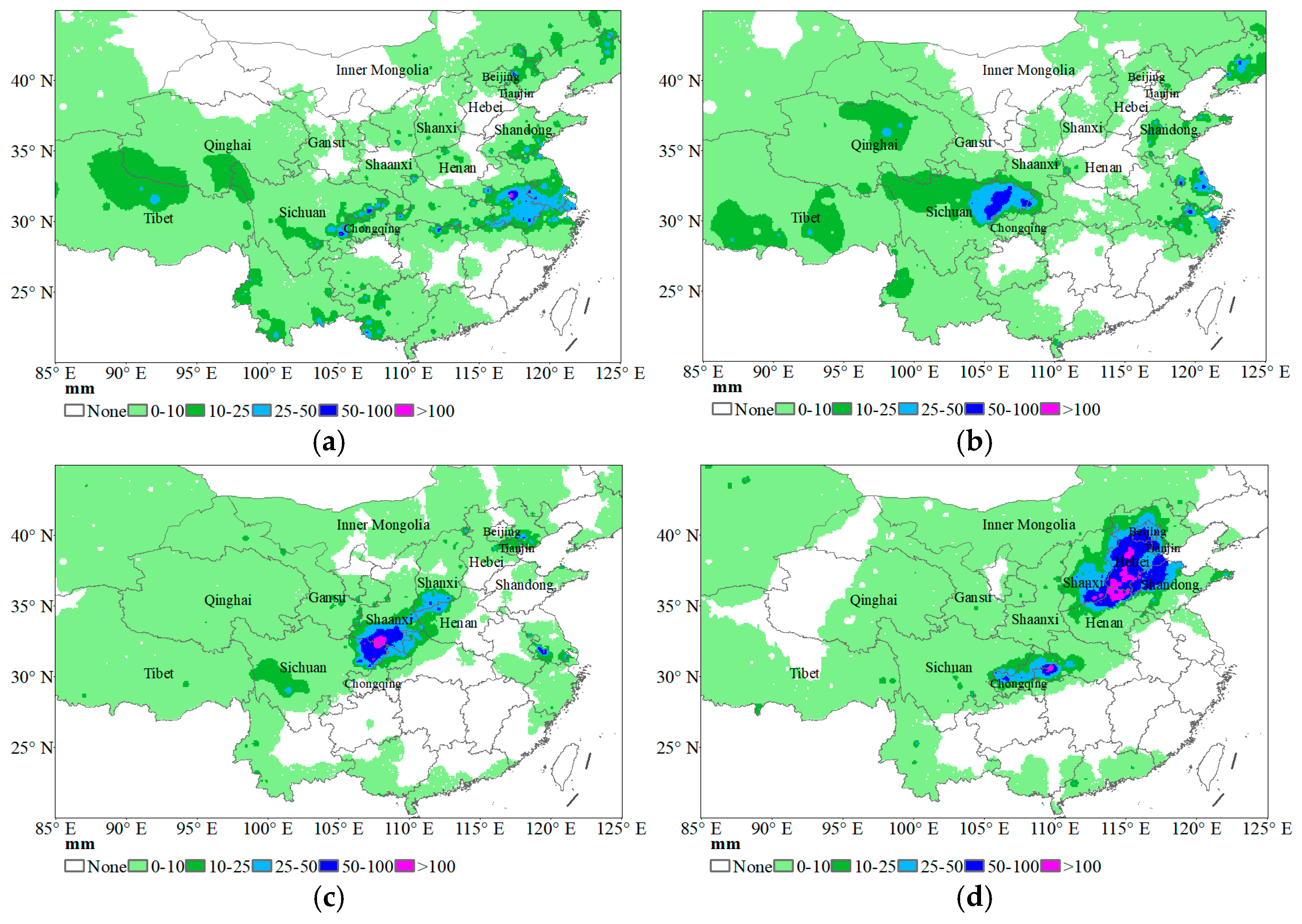
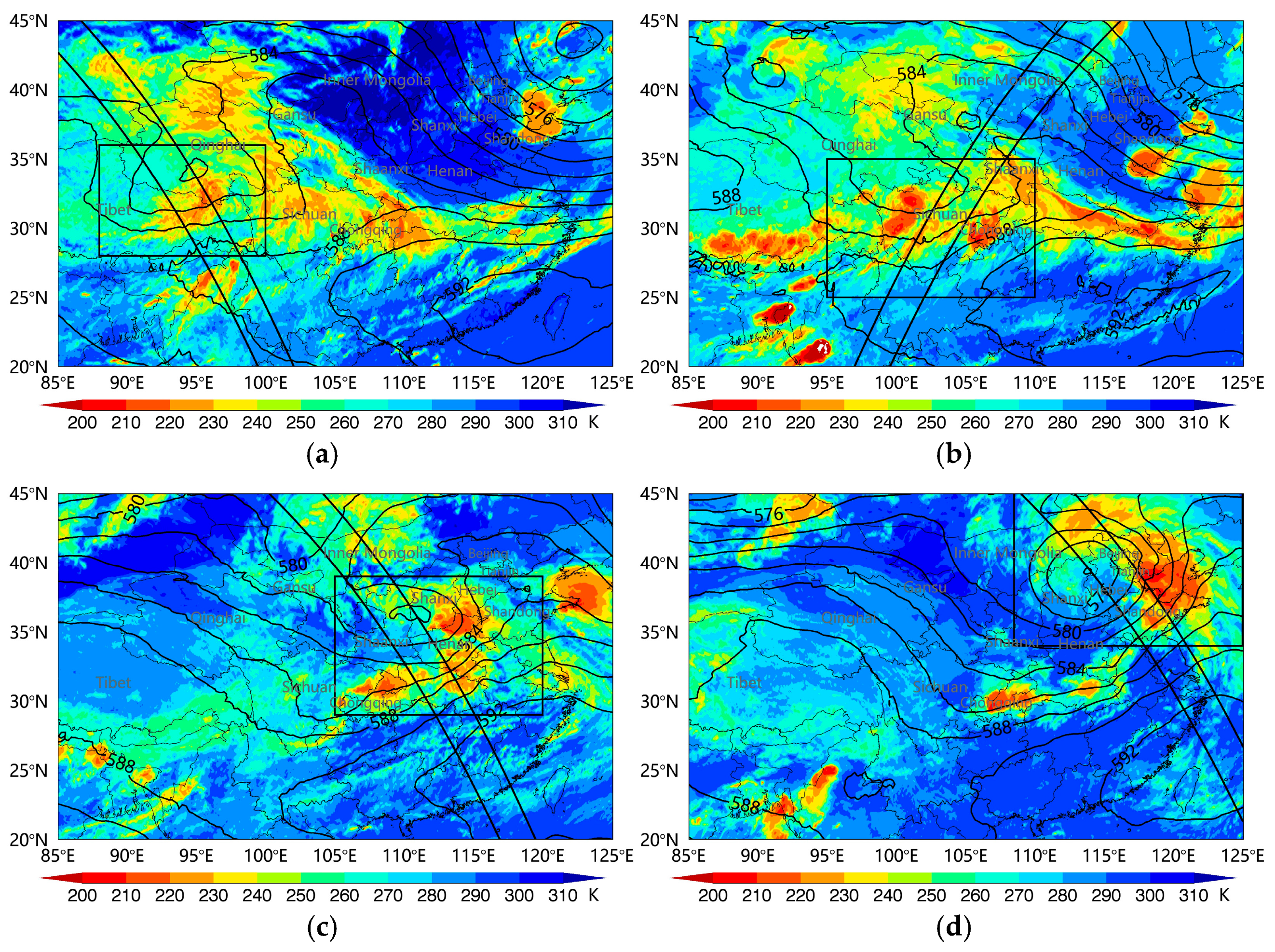
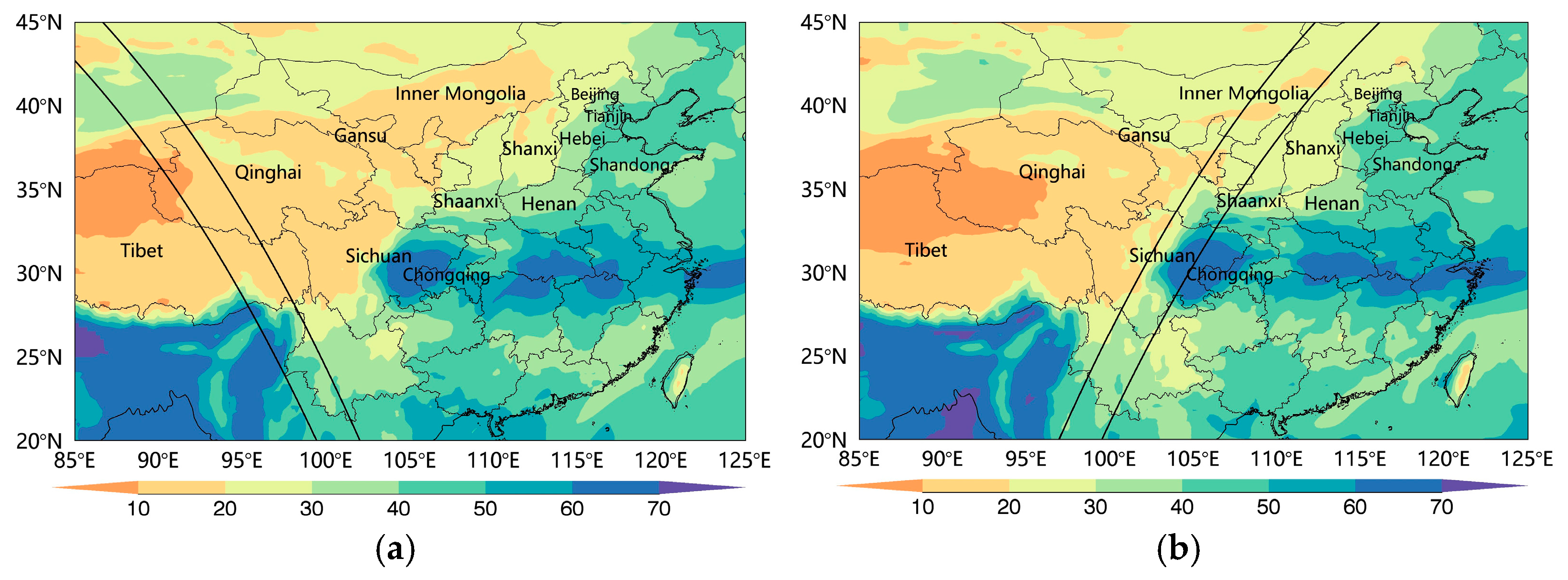
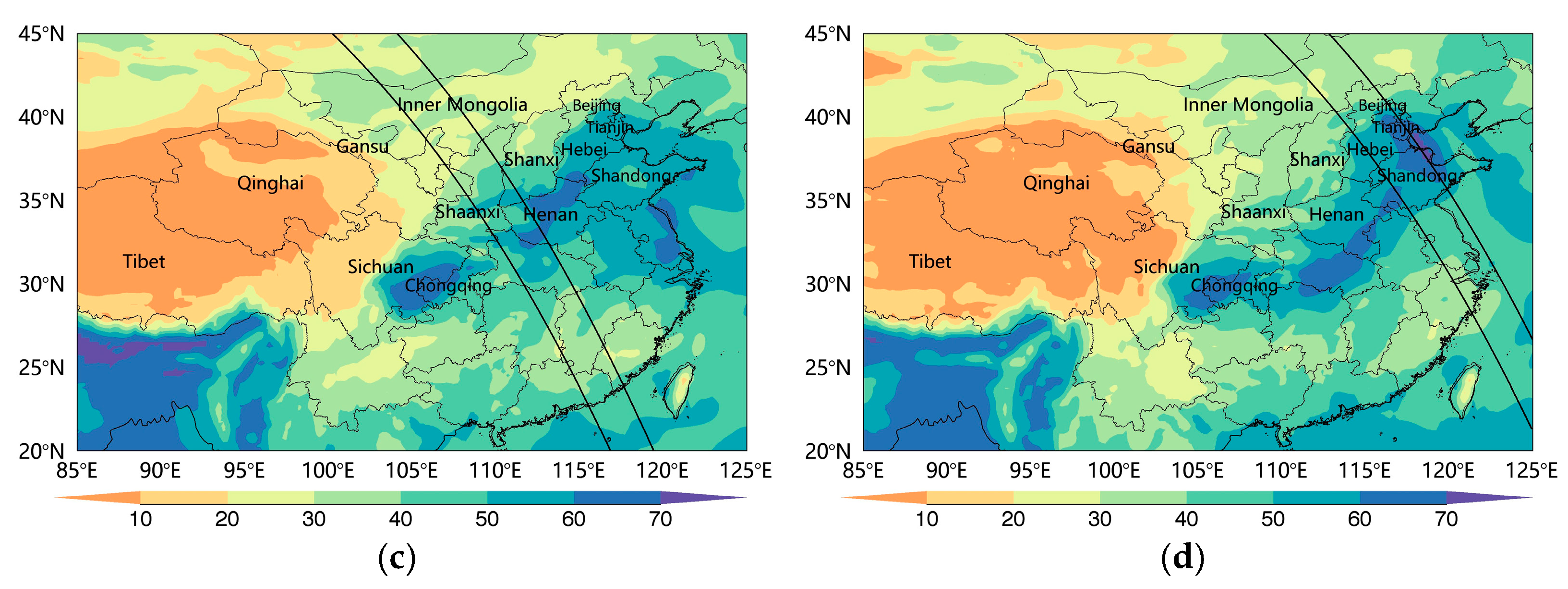
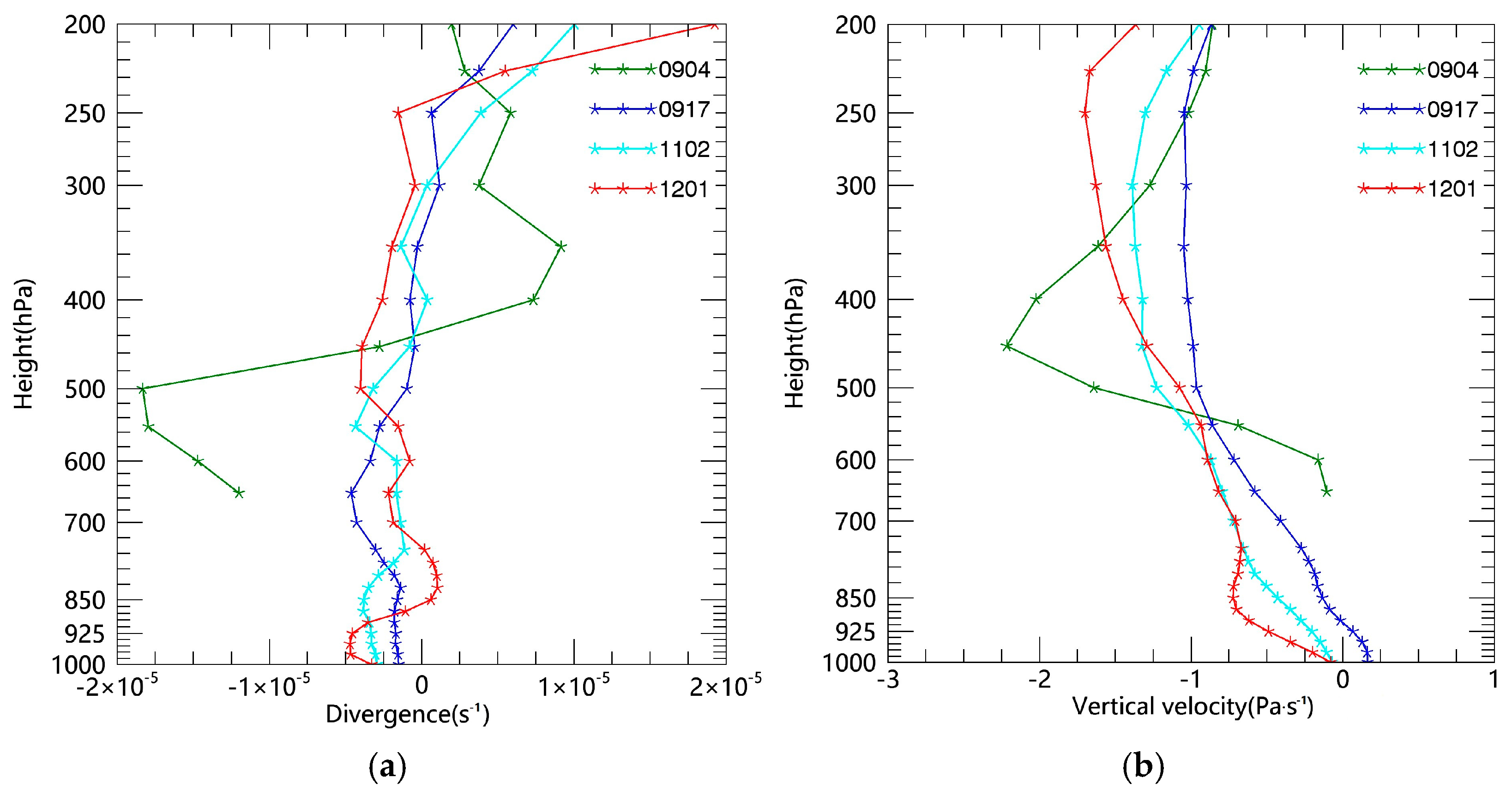
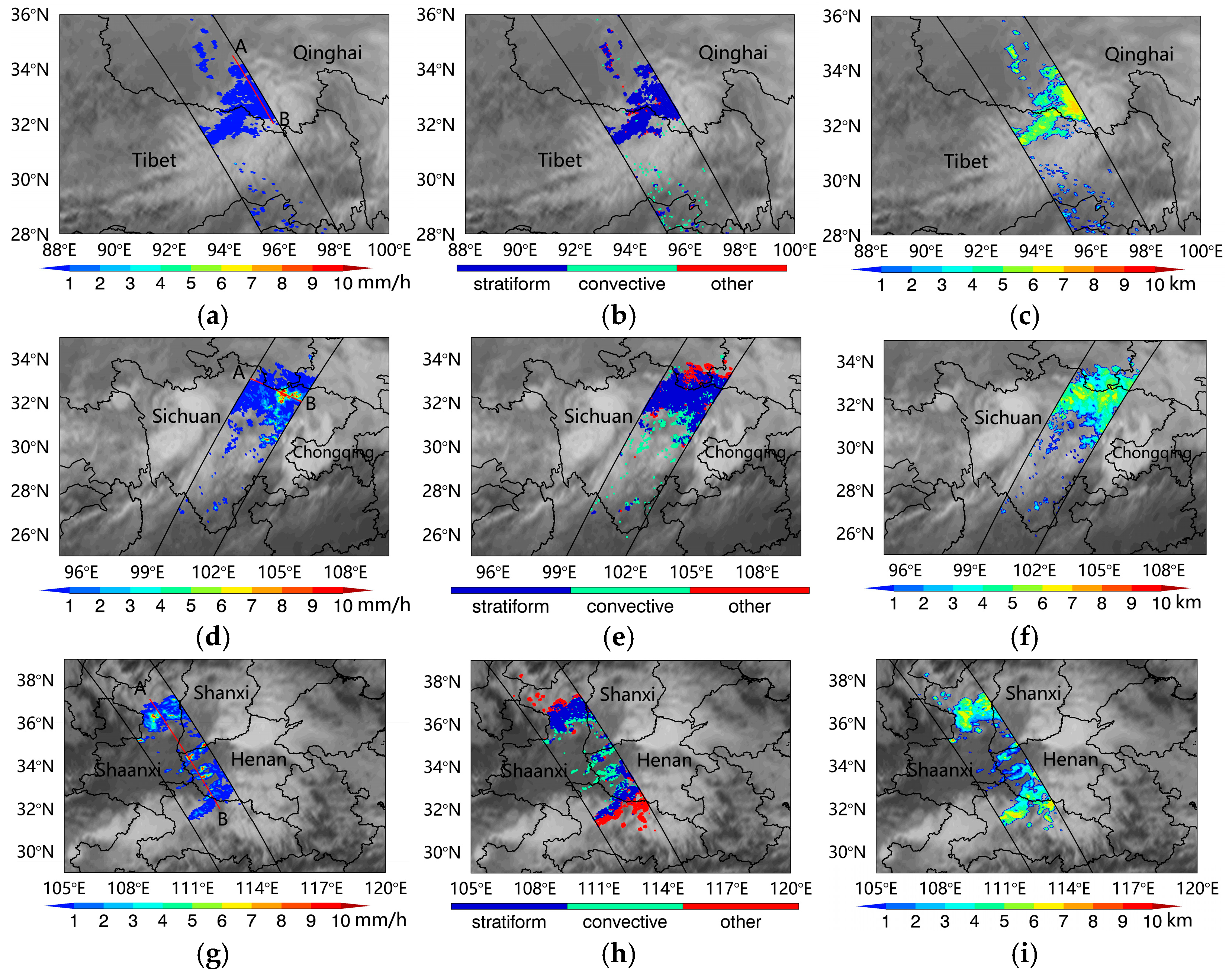

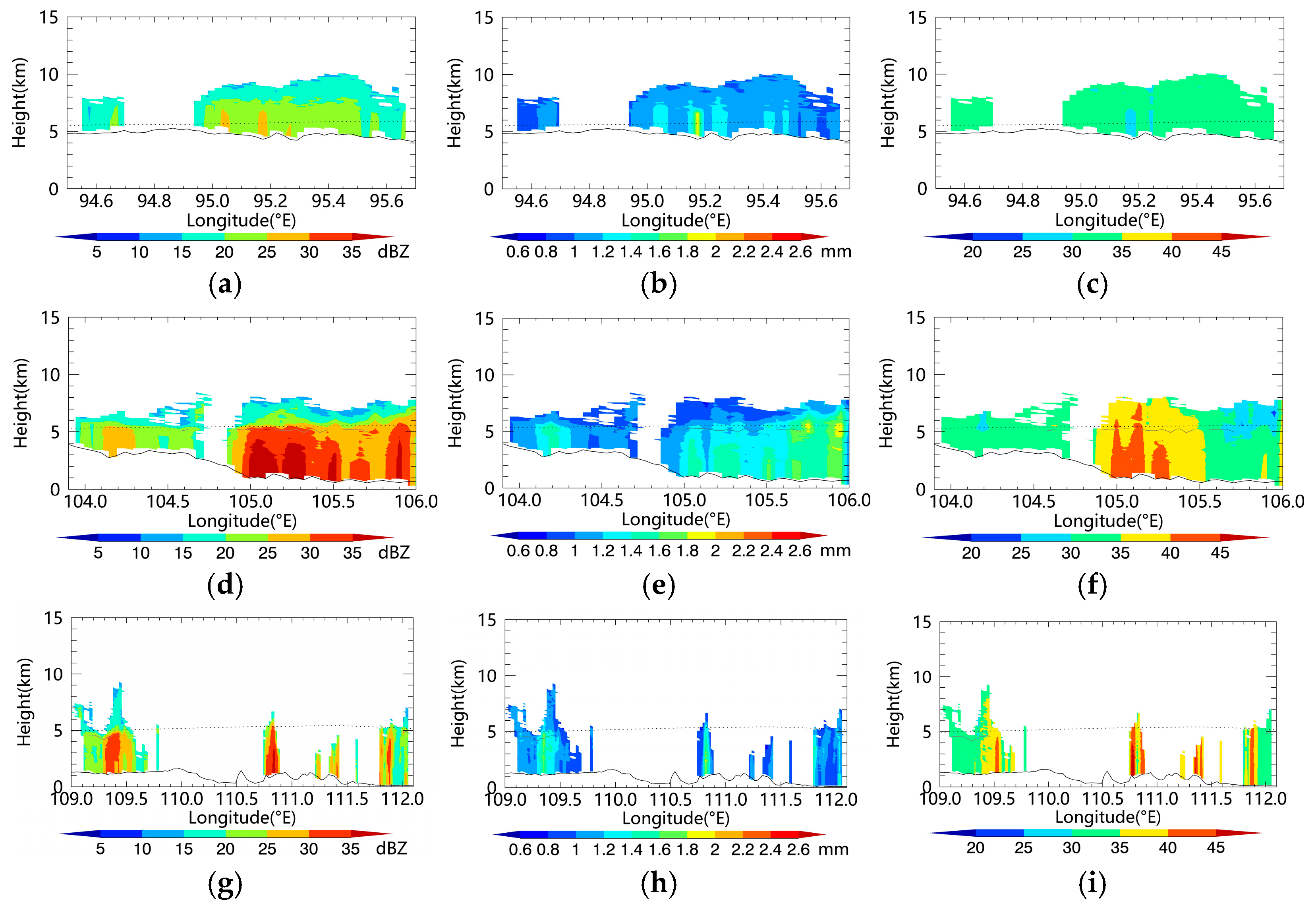

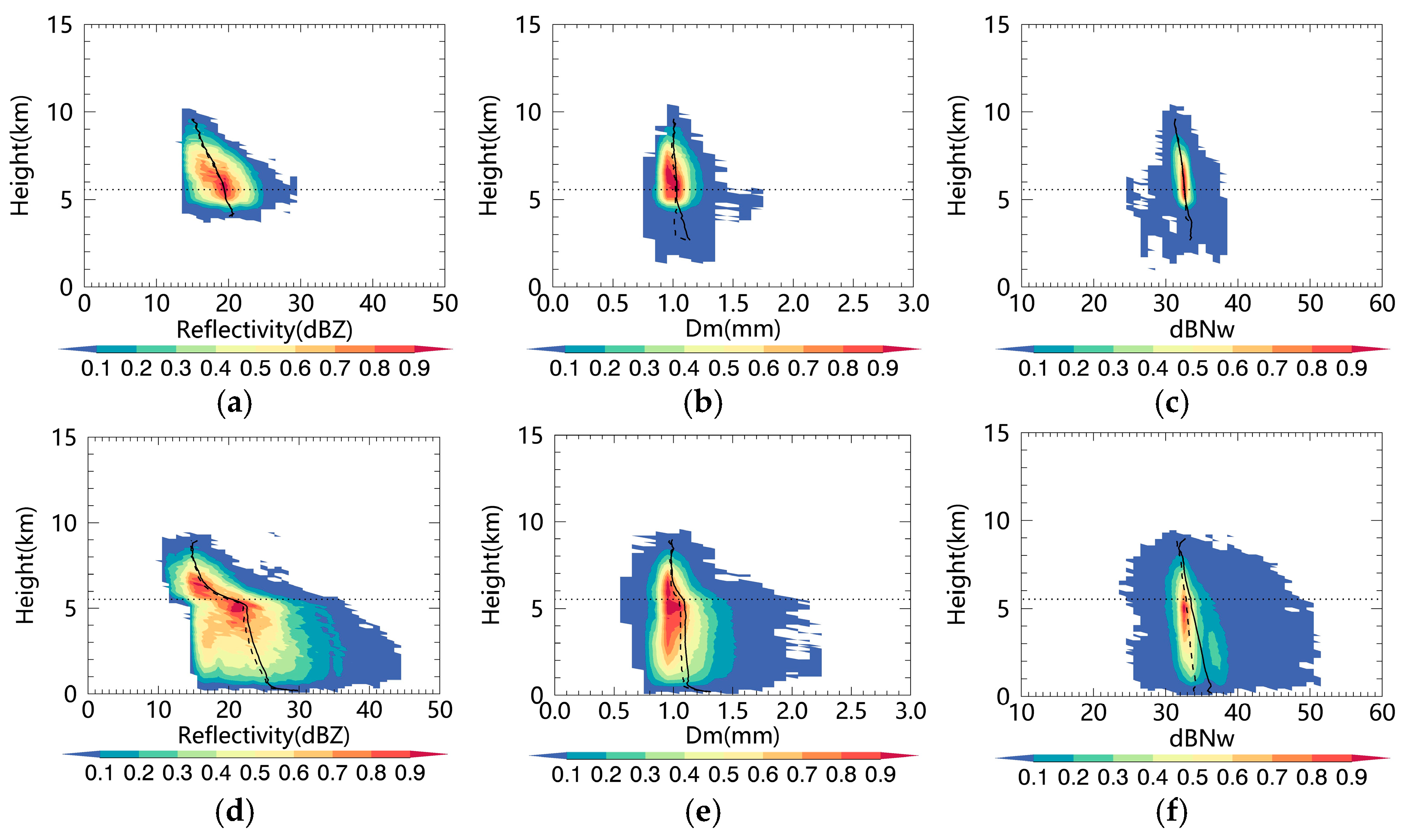
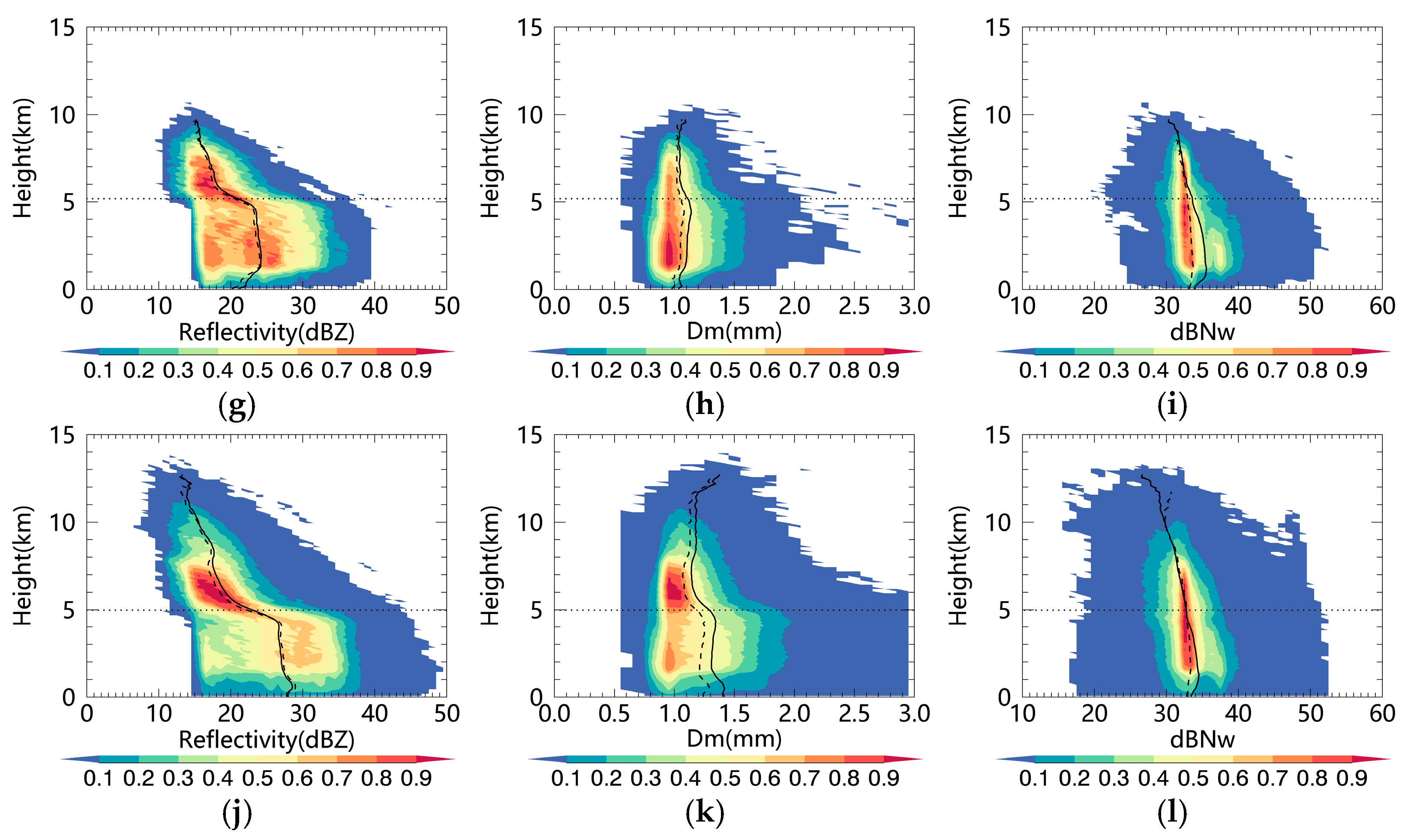
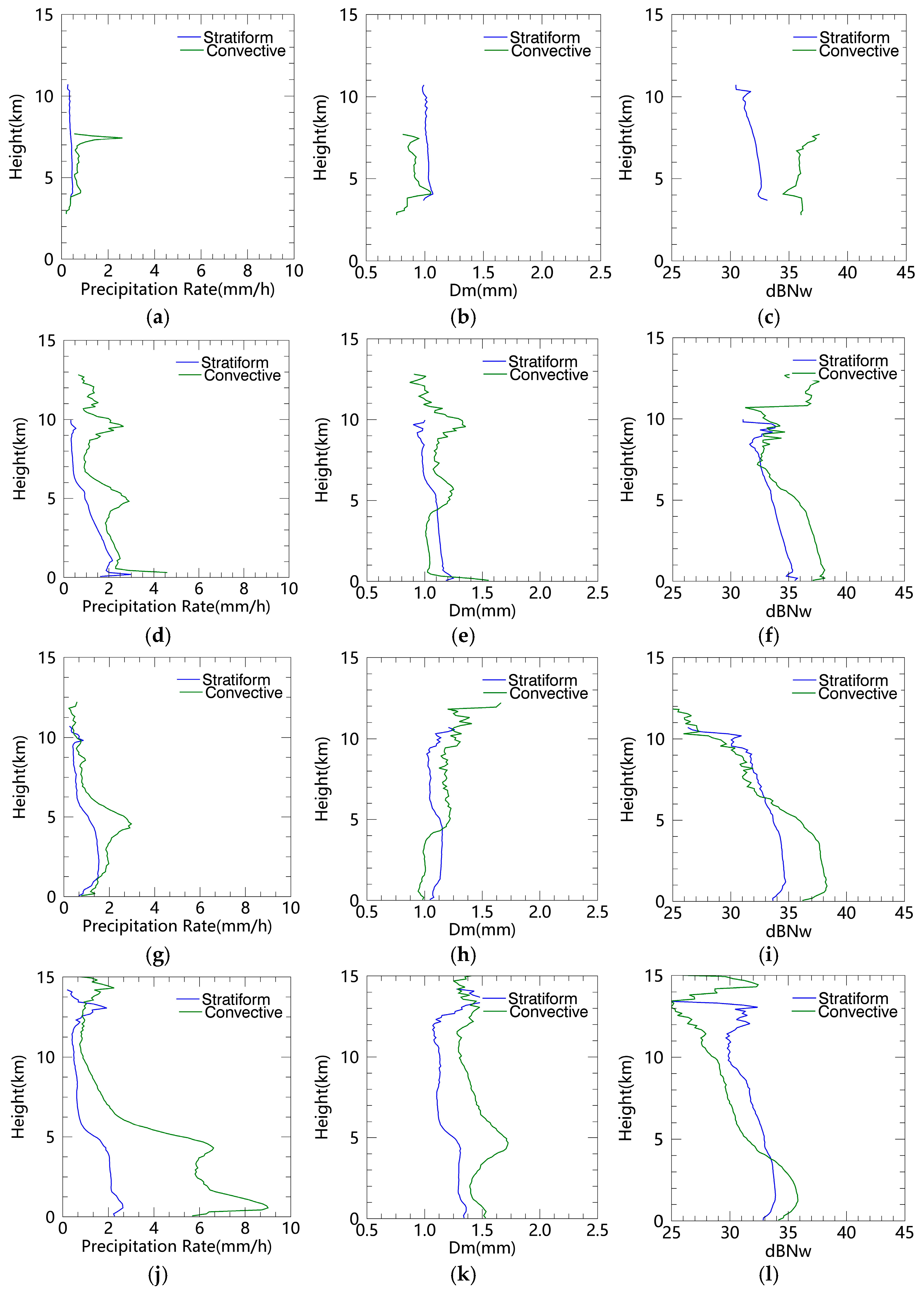


Disclaimer/Publisher’s Note: The statements, opinions and data contained in all publications are solely those of the individual author(s) and contributor(s) and not of MDPI and/or the editor(s). MDPI and/or the editor(s) disclaim responsibility for any injury to people or property resulting from any ideas, methods, instructions or products referred to in the content. |
© 2024 by the authors. Licensee MDPI, Basel, Switzerland. This article is an open access article distributed under the terms and conditions of the Creative Commons Attribution (CC BY) license (https://creativecommons.org/licenses/by/4.0/).
Share and Cite
Yang, B.; Ren, S.; Wang, X.; Niu, N. Precipitation Characteristics at Different Developmental Stages of the Tibetan Plateau Vortex in July 2021 Based on GPM-DPR Data. Remote Sens. 2024, 16, 1947. https://doi.org/10.3390/rs16111947
Yang B, Ren S, Wang X, Niu N. Precipitation Characteristics at Different Developmental Stages of the Tibetan Plateau Vortex in July 2021 Based on GPM-DPR Data. Remote Sensing. 2024; 16(11):1947. https://doi.org/10.3390/rs16111947
Chicago/Turabian StyleYang, Bingyun, Suling Ren, Xi Wang, and Ning Niu. 2024. "Precipitation Characteristics at Different Developmental Stages of the Tibetan Plateau Vortex in July 2021 Based on GPM-DPR Data" Remote Sensing 16, no. 11: 1947. https://doi.org/10.3390/rs16111947




